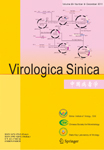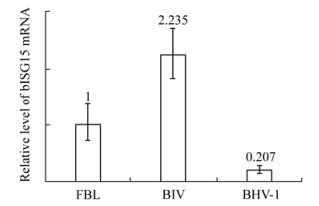-
Boo K H, Yang J S. 2010. Intrinsic cellular defenses against virus infection by antiviral type i interferon. Yonsei Med J, 51(1): 9-17.
doi: 10.3349/ymj.2010.51.1.9
-
Burnside J, Bernberg E, Anderson A, et al. 2006. Marek's disease virus encodes micrornas that map to meq and the latency-associated transcript. J Virol, 80(17): 8778-8786.
doi: 10.1128/JVI.00831-06
-
Dao C T, Zhang D E. 2005. Isg15: A ubiquitin-like enigma. Front Biosci, 10: 2701-2722.
doi: 10.2741/1730
-
de Veer M J, Holko M, Frevel M, et al. 2001. Functional classification of interferon-stimulated genes identified using microarrays. J Leukoc Biol, 69(6): 912-920.
-
Farrell P J, Broeze R J, Lengyel P. 1979. Accumulation of an mrna and protein in interferon-treated ehrlich ascites tumour cells. Nature, 279(5713): 523-525.
doi: 10.1038/279523a0
-
Hansen T R, Austin K J, Johnson G A. 1997. Transient ubiquitin cross-reactive protein gene expression in the bovine endometrium. Endocrinology, 138(11): 5079-5082.
doi: 10.1210/endo.138.11.5655
-
Henderson G, Zhang Y, Jones C. 2005. The bovine herpesvirus 1 gene encoding infected cell protein 0 (bicp0) can inhibit interferon-dependent transcription in the absence of other viral genes. J Gen Virol, 86(10): 2697-2702.
doi: 10.1099/vir.0.81109-0
-
Hiscott J, Pitha P, Genin P, et al. 1999. Triggering the interferon response: The role of irf-3 transcription factor. J Interf Cytok Res, 19(1): 1-13.
doi: 10.1089/107999099314360
-
Johnson G A, Joyce M M, Yankey S J, et al. 2002. The interferon stimulated genes (isg) 17 and mx have different temporal and spatial expression in the ovine uterus suggesting more complex regulation of the mx gene. J Endocrinol, 174(2): R7-R11.
doi: 10.1677/joe.0.174R007
-
Jones C. 2003. Herpes simplex virus type 1 and bovine herpesvirus 1 latency. Clin Microbiol Rev, 16(1): 79-95.
doi: 10.1128/CMR.16.1.79-95.2003
-
Jones C, Geiser V, Henderson G, et al. 2006. Functional analysis of bovine herpesvirus 1 (bhv-1) genes expressed during latency. Vet Microbiol, 113(3-4): 199-210.
doi: 10.1016/j.vetmic.2005.11.009
-
Kim K I, Giannakopoulos N V, Virgin H W, et al. 2004. Interferon-inducible ubiquitin e2, ubc8, is a conjugating enzyme for protein isgylation. Mol Cell Biol, 24(21): 9592-9600.
doi: 10.1128/MCB.24.21.9592-9600.2004
-
Lenschow D J, Lai C, Frias-Staheli N, et al. 2007. Ifn-stimulated gene 15 functions as a critical antiviral molecule against influenza, herpes, and sindbis viruses. Proc Natl Acad Sci USA, 104(4): 1371-1376.
doi: 10.1073/pnas.0607038104
-
Liu C, Chang R, Yao X, et al. 2009. Isg15 expression in response to double-stranded rna or lps in cultured fetal bovine lung (fbl) cells. Vet Res Commun, 33(7): 723-733.
doi: 10.1007/s11259-009-9221-8
-
Liu C, Li X, Yao X, et al. 2010. Bovine isg15: An antiviral and inducible protein in biv infected fetal bovine lung cells. Virol J, 7: 134.
doi: 10.1186/1743-422X-7-134
-
Livak K J, Schmittgen T D. 2001. Analysis of relative gene expression data using real-time quantitative pcr and the 2(-delta delta c(t)) method. Methods, 25(4): 402-408.
doi: 10.1006/meth.2001.1262
-
Lu G, Reinert J T, Pitha-Rowe I, et al. 2006. Isg15 enhances the innate antiviral response by inhibition of irf-3 degradation. Cell Mol Biol (Noisy-le-grand), 52(1): 29-41.
-
Melroe G T, Silva L, Schaffer P A, et al. 2007. Recruitment of activated irf-3 and cbp/p300 to herpes simplex virus icp0 nuclear foci: Potential role in blocking ifn-beta induction. Virology, 360(2): 305-321.
doi: 10.1016/j.virol.2006.10.028
-
Moynihan T P, Ardley H C, Nuber U, et al. 1999. The ubiquitin-conjugating enzymes ubch7 and ubch8 interact with ring finger/ibr motif-containing domains of hhari and h7-ap1. J Biol Chem, 274(43): 30963-30968.
doi: 10.1074/jbc.274.43.30963
-
Okumura A, Lu G, Pitha-Rowe I, et al. 2006. Innate antiviral response targets hiv-1 release by the induction of ubiquitin-like protein isg15. Proc Natl Acad Sci USA, 103(5): 1440-1445.
doi: 10.1073/pnas.0510518103
-
Okumura A, Pitha P M, Harty R N. 2008. Isg15 inhibits ebola vp40 vlp budding in an l-domain-dependent manner by blocking nedd4 ligase activity. Proc Natl Acad Sci USA, 105(10): 3974-3979.
doi: 10.1073/pnas.0710629105
-
Perez S, Inman M, Doster A, et al. 2005. Latency-related gene encoded by bovine herpesvirus 1 promotes virus growth and reactivation from latency in tonsils of infected calves. J Clin Microbiol, 43(1): 393-401.
doi: 10.1128/JCM.43.1.393-401.2005
-
Perry D J, Austin K J, Hansen T R. 1999. Cloning of interferon-stimulated gene 17: The promoter and nuclear proteins that regulate transcription. Mol Endocrinol, 13(7): 1197-1206.
doi: 10.1210/mend.13.7.0294
-
Saira K, Zhou Y, Jones C. 2007. The infected cell protein 0 encoded by bovine herpesvirus 1 (bicp0) induces degradation of interferon response factor 3 and, consequently, inhibits beta interferon promoter activity. J Virol, 81(7): 3077-3086.
doi: 10.1128/JVI.02064-06
-
Shen W, Sa e Silva M, Jaber T, et al. 2009. Two small rnas encoded within the first 1.5 kilobases of the herpes simplex virus type 1 latency-associated transcript can inhibit productive infection and cooperate to inhibit apoptosis. J Virol, 83(18): 9131-9139.
doi: 10.1128/JVI.00871-09
-
Smirnova N P, Bielefeldt-Ohmann H, Van Campen H, et al. 2008. Acute non-cytopathic bovine viral diarrhea virus infection induces pronounced type i interferon response in pregnant cows and fetuses. Virus Res, 132(1-2): 49-58.
doi: 10.1016/j.virusres.2007.10.011
-
Umbach J L, Nagel M A, Cohrs R J, et al. 2009. Analysis of human alphaherpesvirus microrna expression in latently infected human trigeminal ganglia. J Virol, 83(20): 10677-10683.
doi: 10.1128/JVI.01185-09
-
Umbach J L, Kramer M F, Jurak I, et al. 2008. Micrornas expressed by herpes simplex virus 1 during latent infection regulate viral mrnas. Nature, 454(7205): 780-783.












